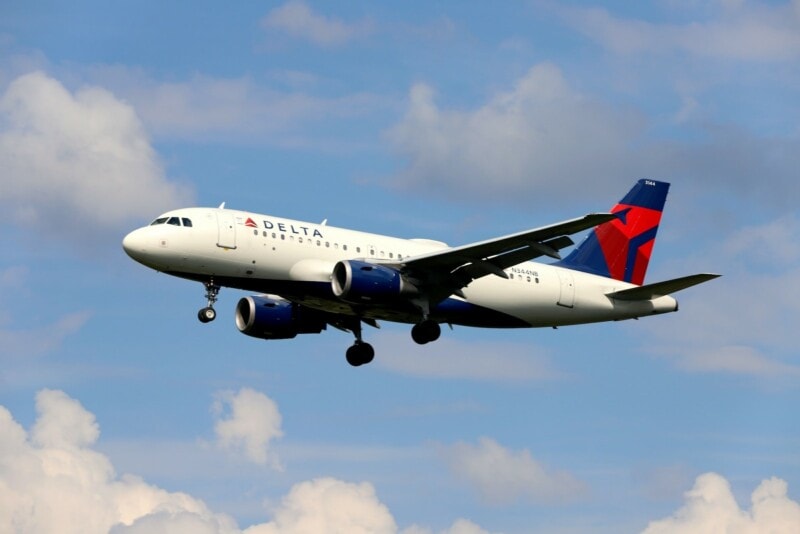


All US airlines with more than 0.5% of the market share are legally required to report on-time performance, delay times, and delay causes for every flight.
The chart below shows the percentages of flights that are on time, delayed, or canceled by each airline in 2022 and 2023.
| Airlines Ranked by 2023 Delay Percentage | ||
| Airline | % Delayed in 2022 | % Delayed in 2023 |
| Republic Airline | 15.8% | 11.9% |
| Endeavor Air | 14.0% | 14.1% |
| SkyWest Airlines | 15.2% | 14.9% |
| PSA Airlines | 16.9% | 14.9% |
| Envoy Air | 15.2% | 16.8% |
| Alaska Airlines | 17.4% | 18.9% |
| Delta Air Lines | 16.4% | 20.0% |
| United Airlines | 19.6% | 23.6% |
| American Airlines | 21.1% | 24.1% |
| Hawaiian Airlines | 21.1% | 25.1% |
| Allegiant Air | 29.4% | 25.5% |
| Southwest Airlines | 27.9% | 26.5% |
| Spirit Airlines | 23.1% | 31.1% |
| JetBlue Airways | 31.3% | 31.2% |
| Frontier Airlines | 31.1% | 34.9% |
Across all domestic flights, 24.1% were delayed or canceled in 2023 (with delayed being defined as departing 15 minutes or more after the scheduled time). The overall average departure time was 14.43 minutes after the scheduled time.
Most On-Time Airline: Republic Airline
Republic Airline has the best flight-on-time performance of all major US carriers in 2023. With only 11.9% of flights departing late, Republic Airline performs about 10% better than the national average. That is a notable improvement from 2022, when Republic had 15.8% of flights delayed.
Republic Airline flights also depart 10 minutes earlier than average, only 4.67 minutes after the scheduled time.
Interestingly, even though it has the best on-time departure rate, Republic has the worst flight cancellation rate, with 3.32% of flights canceled in 2023.
Most Delayed Airline: Frontier Airlines
Frontier is the worst performer. A dismal 34.9% of Frontier domestic flights departed late in 2023. That means well over a third of Frontier flights either depart more than 15 minutes late or are canceled. Frontier’s average flight departure time is 29.43 minutes after the scheduled time.
Flight Delays in Large vs Small Airlines
It is interesting that the top five airlines for on-time percentage in 2023 are all quite small, with less than 3% of the market share. All but SkyWest have less than 1.5% of the market share.
The worst performers (Frontier, JetBlue, and Spirit) are also on the smaller end, though larger than the airlines in the top on-time rankings.
The “Big Four” US airlines (Delta Air Lines, American Airlines, United Airlines, and Southwest Airlines) are all around the middle of the pack. Perhaps that’s only logical though. Because large air carriers operate a massive volume of flights, due to principles of scale, their performance is bound to even out closer to the national average.
On the other hand, smaller airlines are more likely to be outliers simply because they don’t have the same volume and diversity of flights.
Of the Big Four, Delta Air Lines performed best with 78.6% of domestic flights operated by Delta departing on time. Delta also has one of the lowest rates for flight cancellations, just 1.41%.
The fifth-largest airline in the country by revenue, Alaska Airlines is the largest carrier to have an on-time rate better than 80% in 2023.
Budget Airlines and Delays
Perhaps unsurprisingly, budget airlines perform worse when it comes to delayed flights. The bottom four in 2023—Southwest Airlines, Spirit Airlines, JetBlue Airways, and Frontier Airlines—are all lower-cost carriers.
There are many explanations for why budget airlines have more delays. These include staffing issues, insufficient maintenance, and less efficient operations.
On the other hand, there is evidence that budget airlines have an overall positive impact on the punctuality of an airport.
A study by Ha V. Pham at the University of Virginia Department of Economics found that airports with the highest percentage of low-cost airline flights have shorter delay times.
I’ll say that another way. If an airport has more flights from budget airlines, the average delay time for all flights from that airport is lower.
This may seem counterintuitive, but Pham’s research suggests that the quick-turnaround approach of budget carriers frees up airport resources for other airlines to use.



